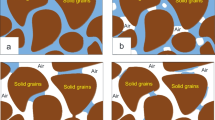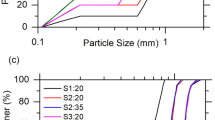Abstract
We define a flow liquefaction potential for determining flow liquefaction susceptibility during proportional strain triaxial compression . The flow liquefaction potential is a function of inconsistency between the natural dilative tendency of the soil and the imposed dilatancy during proportional strain triaxial compression. It helps us analyze why given the right conditions, a loose soil that contracts during drained triaxial compression and liquefies under undrained triaxial compression may be stable under proportional strain triaxial compression. Conversely, we also use the flow liquefaction potential to analyze why a dense soil that dilates during drained triaxial compression and is stable under undrained triaxial compression may liquefy under proportional strain triaxial compression. The undrained loose case is a special case of proportional strain triaxial compression under which a soil can liquefy. The central objective of this paper was to investigate the origins of flow liquefaction instability. Hence, we also analyze stress evolution during proportional strain triaxial compression and discuss the mechanics of the test leading up to flow liquefaction instability. We arrive at a necessary precursor for instability, which can serve as a warning sign for flow liquefaction instability, while the soil is still stable. The precursor is not a condition of sufficiency and should also not be confused with the onset of instability itself. The same loading must be applied continuously to induce flow liquefaction instability. The current progress is encouraging and facilitates a deeper understanding of origin of flow liquefaction instabilities.










Similar content being viewed by others
References
Andrade JE (2009) A predictive framework for liquefaction instability. Géotechnique 59(8):673–682
Castro G (1969) Liquefaction of sands, Harvard soil mechanics series 81. Harvard University, Cambridge
Chu J, Lo SCR, Lee IK (1993) Instability of granular soils under strain path testing. J Geotech Eng 119(5):874–892
Cundall PA, Strack ODL (1979) A discrete numerical model for granular assemblies. Géotechnique 29(1):47–65
Daouadji A, Darve F, Al Gali H, Hicher PY, Laouafa F, Lignon S, Nicot F, Nova R, Pinheiro M, Prunier F et al (2011) Diffuse failure in geomaterials: experiments, theory and modelling. Int J Numer Anal Methods Geomech 35(16):1731–1773
Daouadji A, Hicher PY, Jrad M, Sukumaran B, Belouettar S (2013) Experimental and numerical investigation of diffuse instability in granular materials using a microstructural model under various loading paths. Géotechnique 63(5):368–381
Darve F, Pal O (1997) Liquefaction: a phenomenon specific to granular media. In: Proceedings of the 3rd international conference on powders & grains, pp 69–73
Darve F, Servant G, Laouafa F, Khoa HDV (2004) Failure in geomaterials: continuous and discrete analyses. Comput Methods Appl Mech Eng 193(27):3057–3085
Galindo-Torres SA, Pedroso DM, Williams DJ, Mühlhaus HB (2013) Strength of non-spherical particles with anisotropic geometries under triaxial and shearing loading configurations. Granul Matter 15(5):531–542
Ishihara K (1993) Liquefaction and flow failure during earthquakes. Géotechnique 43(3):351–451
Khoa HDV, Georgopoulos IO, Darve F, Laouafa F (2006) Diffuse failure in geomaterials: experiments and modelling. Comput Geotech 33(1):1–14
Kramer SL (1996) Geotechnical earthquake engineering. Prentice Hall, Upper Saddle River
Lade PV (1992) Static instability and liquefaction of loose fine sandy slopes. J Geotech Eng 118(1):51–71
Liu H, Qiao T (1984) Liquefaction potential of saturated sand deposits underlying foundation of structure. In: Proceedings of the 8th world conference on earthquake engineering, San Francisco, CA, pp 21–28
National Research Council (1985) Liquefaction of soils during earthquakes. National Academy Press, Washington, DC
Ramos AM, Andrade JE, Lizcano A (2012) Modelling diffuse instabilities in sands under drained conditions. Géotechnique 62(6):471–478
Seed HB (1987) Design problems in soil liquefaction. J Geotech Eng 113(8):827–845
Vaid YP, Chern JC (1983) Effect of static shear on resistance to liquefaction. Soils Found 23(1):47–60
Vaid YP, Eliadorani A (1998) Instability and liquefaction of granular soils under undrained and partially drained states. Can Geotech J 35(6):1053–1062
Whitman RV (1985) On liquefaction. In: Proceedings of the 11th international conference on soil mechanics and foundation engineering, San Francisco, CA, pp 12–16
Wood DM (1990) Soil behaviour and critical state soil mechanics. Cambridge University Press, Cambridge
Acknowledgments
The authors would like to acknowledge the help provided by S.A. Galindo-Torres in running the simulations.
Author information
Authors and Affiliations
Corresponding author
Rights and permissions
About this article
Cite this article
Mital, U., Andrade, J.E. Mechanics of origin of flow liquefaction instability under proportional strain triaxial compression. Acta Geotech. 11, 1015–1025 (2016). https://doi.org/10.1007/s11440-015-0430-8
Received:
Accepted:
Published:
Issue Date:
DOI: https://doi.org/10.1007/s11440-015-0430-8




